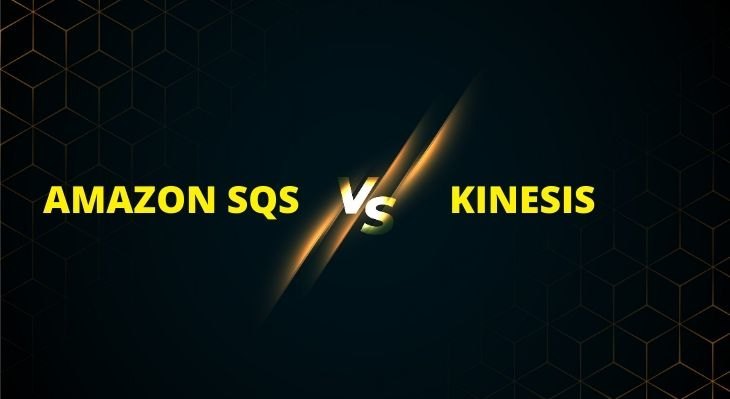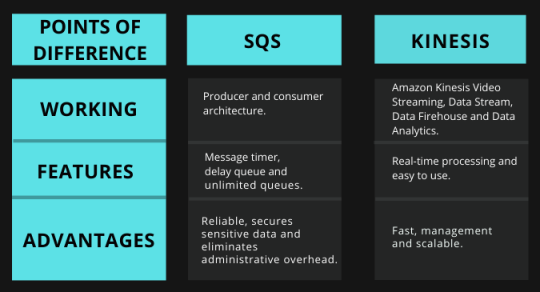Software applications are expected to communicate with each other in order to complete their process smoothly.
For this, they are dependent on message brokers.
Message brokers are the ones responsible for the processing of messages.
They are mostly used in situations where the data size count is in millions or billions.
Amazon SQS and Kinesis both act as message brokers.
Amazon SQS is a fully managed message queuing service that sends and receives the messages from software components irrespective of their volumes.
With Amazon SQS, a user has the ability to exchange messages of any volume between multiple systems without losing them.
Whereas Amazon Kinesis collects as well as processes tone of real-time data from multiple sources, allowing users to react to new information quickly.
Detailed difference between the Amazon SQS and Amazon Kinesis
Here’s the working architecture of Amazon SQS:
Working of Amazon SQS is based on the model of producer and consumer-based architecture.
Whenever a producer sends a message, the consumer polls the queue for new messages.
The consumer has to delete the message after processing; otherwise, the message will be visible even after the visibility timeout.
If the Simple Queue method is used, the messages are not expected to be in the ordered form.
You can have the messages in an ordered form with the FIFO Queue method.
However, in case of repeated failure of the message, the same needs to be defined in the Dead Letter Queue and processed in the FailureDLQ before the message expires.
Let’s explore the working of Amazon Kinesis through its several functionalities:
Amazon Kinesis Video Streaming
Data is collected from multiple cameras and securely uploaded with the help of the Kinesis Video Stream.
Kinesis video stream prepares the video for encryptions and real-time batch analytics.
Real-time and machine learning applications use Kinesis video stream API to access and retrieve the indexed video.
Amazon Kinesis Data Streams
Data is captured from multiple sources and is sent to Kinesis data streams.
Amazon Kinesis Data Streams stores the data for processing.
This data can be utilized in many ways, like building customized and real-time applications or performing stream processing frameworks like Apache Spark.
Users can then use any of their favourite business intelligence tools to understand the outputs.
Amazon Kinesis Data Firehouse
Data captured is sent to Amazon Kinesis Data Firehouse.
Kinesis data firehouse is continuously loaded and prepared for the chosen destinations.
Streamed data hereafter is stored for analytics with the help of tools like Splunk and Amazon Elasticsearch service for analysis.
Amazon Kinesis Data Analytics
Streaming data is collected with the help of Kinesis data firehouse and Kinesis data streams.
Amazon Kinesis Data Analytics is used for query purposes and for analyzing streaming data.
For allowing users to create alerts and respond quickly, Amazon Kinesis Data Analytics sends processed data to analytics tools.
Also Read: Google Home v/s Amazon Echo? Which is Better?
Below mentioned are some of the features of Amazon SQS:
- Message Timer allows users to set time for the invisibility of message.
- Delay queue postpones messages, makes messages invisible, and delays the messages for the duration of 0 to 15 minutes.
- Creating unlimited queues and messages.
- Sending and reading messages simultaneously.
Some of the key features of Amazon Kinesis are as under:
- Real-time processing allows users to collect information in real-time.
- Being easy to use allows users to create new streams.
- Automatically provisioning and managing the storage needed to collect data streams.
Below mentioned are some of the benefits of Amazon SQS:
Eliminating Administrative Overhead
AWS maintains efficient operational progress for a scalable message queuing service.
With the presence of AWS SQS, there is no need for support infrastructure or installation of messaging packages.
Queues are dynamically created and automatically scaled in Amazon SQS.
This, thus allows users to build and grow applications quickly and with efficiency.
Reliably Delivering Messages
Deliver any amount of data without the loss of messages.
SQS allows users to decouple the components of applications in order to allow them to run and fail independently.
For ready access, messages are stored in multiple copies at multiple zones.
Securing Sensitive Data
Messages are kept safe with the help of encryption.
Messages can be transferred among the applications, using server-side encryption with the help of Amazon SQS.
Integration of Amazon SQS with AWS Key management service allows users to manage the key protecting SQS messages centrally.
Elastically Scaling and Cost-effective
Amazon SQS uses the AWS cloud to match the scale requirements based on demand.
SQS scales with user’s applications so that the user has not to worry about storage planning.
Costs are based on the usage patterns.
Some of the benefits of Amazon Kinesis are as below:
Fast
Since AWS Kinesis is able to process data whenever it is needed. This thus helps in driving insights into data quickly rather than waiting for a long time.
Management
No infrastructure is needed to be managed by the user as Kinesis is efficient in running applications.
Scalable
It has the ability to handle a large amount of data and processes it from multiple sources.
Applications of Amazon SQS can be better understood with below mentioned real-life instances wherein they proved to be useful
BMW Was Able To Overcome The Challenge of Load Requirements
BMW 7 series cars were installed with a sensor that would collect data from onboarded sensors.
It will then upload the same data to cloud services.
The main objective behind this was to give efficient digital services to customers.
This included new maps, accurate speed limits, improved road geometries, fewer map errors, much better root guidance for all BMW connected driving customers.
BMW was able to build its car-as-a-sensor (CARASSO) service with the help of Amazon simple Queue Service and other Amazon platforms.
By running on AWS, CARASSO was observed to be adapting to changing requirements that we’re scaling up and down by two orders of magnitude within 24 hours.
Change Healthcare Was Able To Minimize Their IT Costs
By using AWS, Change Healthcare was able to test new services for its customers quickly.
Change Healthcare, with the help of AWS and Amazon SQS, handled millions of confidential transactions daily.
Moreover, with the help of AWS, they were able to scale up to satisfy the growing demands and that too by minimizing IT costs.
Oyster Was Able To Improve Their Image Processing Speed.
Oyster has published more than a million high-quality digital images.
The previous solutions used in the Oyster for reprocessing the images used to take 800 hours to complete.
The majority of processing work of Oyster is now happening on the AWS cloud.
This thus reduced their hardware costs too.
Oyster currently is using a customized Amazon Linux AMI within Amazon EC2.
Oyster now depends on Amazon EC2 instances and Amazon SQS for generating the sizes they need for each photo.
The company, now with the help of AWS was able to process the same number of photos as earlier in just 20 hours.
Now, we’ll be understanding the applications of Amazon Kinesis with the help of cases studied discussed below
Yieldmo Improved Its Advertising Campaign Effectiveness
Being into the advertising business, it was crucial for the Yieldmo to know user behaviour in real-time.
With Amazon Kinesis services, Yieldmo was able to retrieve data in real-time related to user behaviour.
With the help of Amazon Kinesis services, Yieldmo was able to create sessions for user’s interactions in real-time.
Yieldmo used Amazon Kinesis Data Analytics to combine user interactions and define active user sessions.
Yieldmo, with the help of standard SQL code, was able to compute ad-view percentages and pixel-by-pixel ad-view time.
This data was further used to deliver Amazon simple storage services with the help of Amazon Kinesis Data Firehose for user-level engagement analytics.
The same data was then uploaded to the company warehouse, from where it was served to customers.
Netflix Improved Their Customer Experience With Real-time Monitoring
From database to storage needs, Netflix uses Amazon Web Service.
This often leads to complex network environments.
To improve its customer experience, monitoring and optimizing the network is a priority for Netflix.
Data stored in logs reflect the communications between two IP addresses. However, on a platform like Netflix, IP addresses alone mean nothing.
The solution Netflix used to analyze network data was Dredge.
With the help of Amazon Kinesis Data Streams, it centralized the log flows.
Dredge reads data from Amazon Kinesis Data Streams in real-time.
This helped in understanding the network environment better by enriching IP addresses with application metadata.
Amazon Kinesis Data Streams based solutions helped in the processing of billions of traffic flows.
With the tons of data getting showed up in analytics in real-time within seconds proved to be scalable for Netflix.
Thus Netflix was able to identify new ways for optimizing its applications.
Thomson Reuters was able to improve their event frequency
Thomson Reuters offers multiple products to its customers.
Thomson Reuters wanted to build its own system that will help them have more insights about the data they collected from their offerings.
Thomson Reuters, already being a user of Amazon Web Services, knew its potential.
Thomson Reuters’ product, known as Product Insight, is dependent on the majority of Amazon Web Services.
Amazon Kinesis streaming data pipeline batches data and delivers them into master data sets.
These data sets are permanently stored in Amazon Simple Storage Services bucket.
In case of any issue related to dispatch of events from the ingestion layer to the data pipeline, a failover mechanism delivers them to Amazon Simple Storage Services.
After the system returns to normal operation, these events can be replayed.
Product Insight on AWS was able to process 4,000 events per second; however, it was expected to accommodate only 2,000 events.
Within a year, Thomson Reuter is expected to increase these event numbers to 10,000 events per second.
Conclusion:
Both Amazon SQS and Amazon Kinesis are good at what they do. The difference lies in the architecture a user is adapting.
SQS provides fully manageable message queuing services whereas if real-time data is your requirement then Amazon Kinesis is the best option.
Also Read: Satellite as a Service Explained


